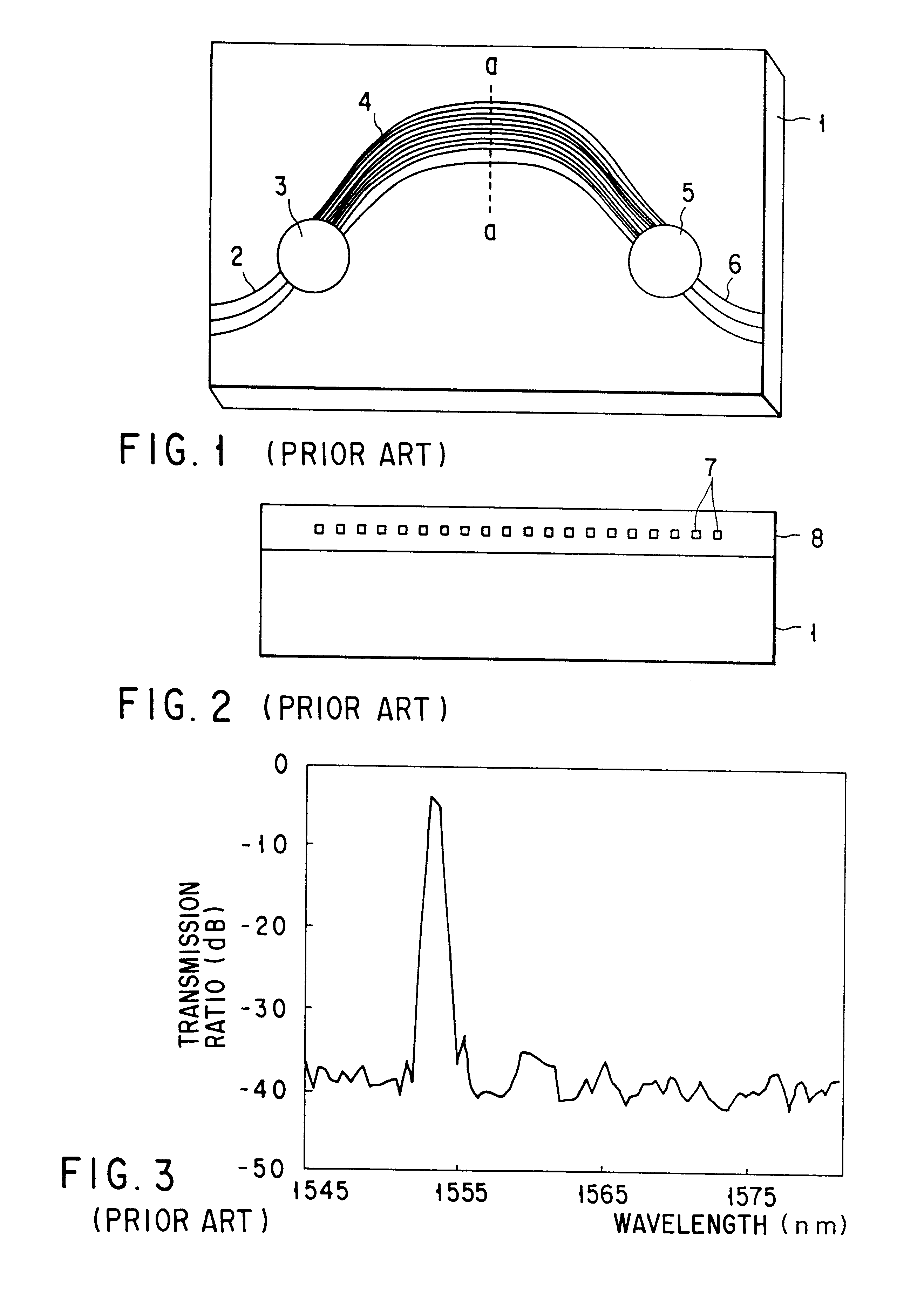Optical waveguide circuit, its manufacturing method and optical waveguide module having the optical waveguide circuit
a manufacturing method and optical waveguide technology, applied in the field of optical waveguide circuits, its manufacturing methods and optical waveguide modules having optical waveguide circuits, can solve the problems of unnecessary temperature control, increase the volume and price of the entire lightwaveguide grating multiplexer, and complicate the structur
- Summary
- Abstract
- Description
- Claims
- Application Information
AI Technical Summary
Benefits of technology
Problems solved by technology
Method used
Image
Examples
first embodiment
FIG. 8 shows a temperature independent arrayed-waveguide grating multiplexer according to a first embodiment of the present invention, and FIG. 9 shows an enlarged sectional view taken along the line b-b' in FIG. 8. An arrayed-waveguide 4 shown in FIG. 8 of the conventional arrayed-waveguide grating multiplexer (FIG. 1) is provided at its central portion with a straight waveguide portion 11 for forming a groove. Si substrate 1, input waveguide 2, a first slab waveguide 3, a second slab waveguide 5, output waveguide 6 and a groove 12 are provided.
A method for producing the waveguide of the invention will be described with reference to FIG. 10.
Step Q1: A quartz glass is accumulated on the Si substrate 1 in an amount of 30 .mu.m by flame-accumulating process, and is transparentized in an electric furnace.
Step Q2: Then, a core glass in which Ge is added is accumulated on the glass film which is accumulated in step Q1 in an amount of 7 .mu.m by flame-accumulating process, and is transpar...
second embodiment
A second embodiment is the same as the first embodiment except that a gelled polymethyl phenyl siloxane was used as a temperature compensating material. In the present embodiment, vinyl terminal polymethyl phenyl siloxane, methyl hydride siloxane and platinum catalyst were charged into the groove and reacted for 30 minutes at 150.degree. C., thereby preparing a temperature compensating material. Substantially the same effect as the first embodiment was confirmed.
third embodiment
FIG. 13 shows a temperature independent arrayed-waveguide grating multiplexer according to a third embodiment, and FIG. 14 shows an enlarged sectional view taken along the line c-c' in FIG. 13. The third embodiment differs from the first embodiment in that a plurality of narrow grooves are formed by photolithography and reactive ion etching. As shown in FIG. 15, a radiation loss is abruptly increased with respect to a width of the groove of the present invention, i.e., a length of the cut waveguide. Therefore, a radiation loss when ten grooves of 10 .mu.m width are formed is smaller than a radiation loss when a single groove of 100 .mu.m width is formed.
Thereupon, taking reproduction performance of etching into account, the minimum groove width was set to be 10 .mu.m, and the number of grooves was set five. A length of the cut waveguide is increased by 0.25 .mu.m each. At that time, a radiation loss was 1 dB. As compared with the first embodiment, the radiation loss is reduced down ...
PUM
 Login to View More
Login to View More Abstract
Description
Claims
Application Information
 Login to View More
Login to View More - R&D
- Intellectual Property
- Life Sciences
- Materials
- Tech Scout
- Unparalleled Data Quality
- Higher Quality Content
- 60% Fewer Hallucinations
Browse by: Latest US Patents, China's latest patents, Technical Efficacy Thesaurus, Application Domain, Technology Topic, Popular Technical Reports.
© 2025 PatSnap. All rights reserved.Legal|Privacy policy|Modern Slavery Act Transparency Statement|Sitemap|About US| Contact US: help@patsnap.com



